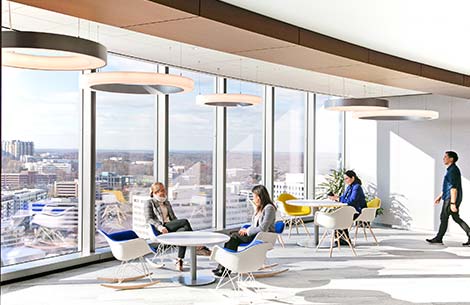My speaking engagements frequently take me to college campuses, where I have the opportunity to connect with professors and administrators about the hot topics on their campuses. For the past few years, I’ve been struck by the number of times leaders at a wide variety of colleges and universities have talked to me about the overwhelming mental health needs of today’s Generation Z students.
Recent statistics confirm that there have been significant increases in students seeking and receiving mental health support in college. According to one study on treatment and diagnosis, the rate of student treatment has increased from 19% in 2007 to 34% a decade later, and the percentage of students with lifetime diagnoses has increased from 22% to 36%.
As these young adults graduate from college and enter the workplace, employers are continuing to offer support. This, of course, helps employees of all generations with mental health concerns.
Here are three ways that your organization can help support mental health for all generations of employees:
1. Consider how workplace design can contribute to mental health.
Nearly 90% of employees agree it’s important that employers provide spaces and programs to support mental health and well-being, finds the 2019 Capital One Work Environment Survey. And that’s sometimes easier to attain than you might think.53% of respondents to the survey said that access to natural light was an essential mental health resource that would improve their satisfaction at work, with almost 60% of employees calling it their most desired design element—the third year in a row that sunshine has topped the list.
Besides letting in the light, workplaces should offer space for employees to retreat and unplug. Fifty percent of employees across generations said they crave quiet spaces in the office so they can take a mental break and recharge. That’s up from 25% in the 2018 study, a clear indication that the desire for self-care is accelerating.
2. Help remove any stigma by raising awareness.
Business is increasingly realizing it can play a role in normalizing mental health. For example, companies like Lyft and Rent the Runway participated in a “National Mental Health Break” during this year’s Mental Health Awareness Month in May.
Deloitte has named a U.S. chief well-being officer, who instituted a program called Mental Health @ Work, and the firm has developed a “Vitality” app to help associates better manage their energy.
And a nonprofit in California, One Mind at Work, is working to establish the “gold standard for workplace mental health and well-being,” with support from companies like Bank of America, Walgreens and Levi Strauss & Co.
3. Encourage flexibility as a way to promote increased mental health.
The Capital One study found that nearly two in three millennials said that flexible schedules played a key role in fostering well-being and promoting satisfaction at work. Flexibility allows workers to take the time they need, when they need it, offering them a sense of control over their work life.
That’s crucial, considering that the World Health Organization (WHO) recently included “burnout” in its new edition of the International Classification of Diseases, describing it as “a syndrome conceptualized as resulting from chronic workplace stress that has not been successfully managed.”
Report after report confirms that flexible scheduling is increasingly vital to attract and retain workers—and with good reason., It’s one of the perks that is beneficial for all generations in the workplace.
As you consider what might bolster your team’s well-being, consider adopting some of these simple yet beneficial workplace design and awareness practices to support members of all generations.
Not Authorized
You are currently not authorized to access this section.
Please contact your Administrator to change your authorization settings.
Please contact your Administrator to change your authorization settings.

Mental Health at Work: Workplace Design Matters for All Generations
September 30, 2019

